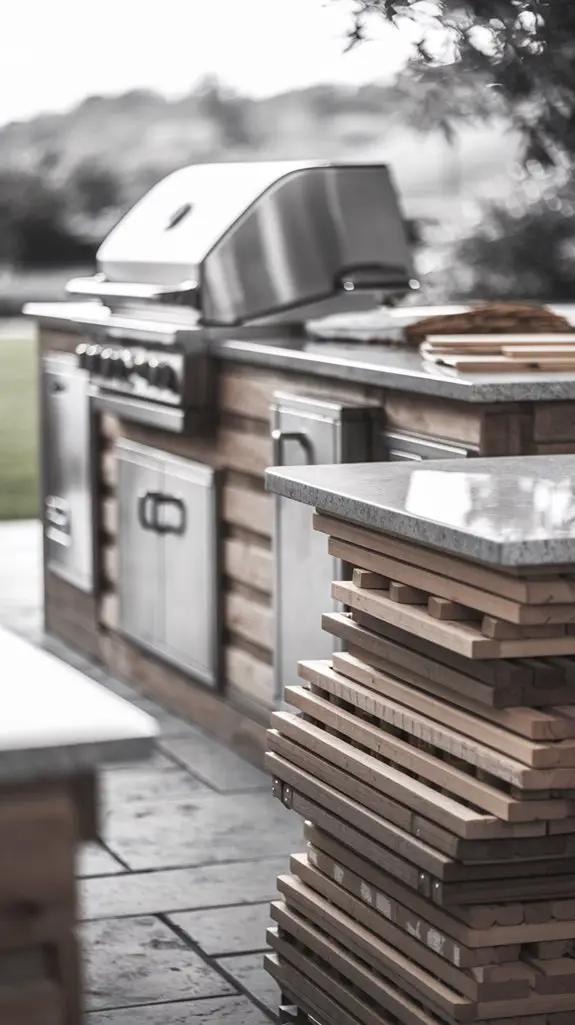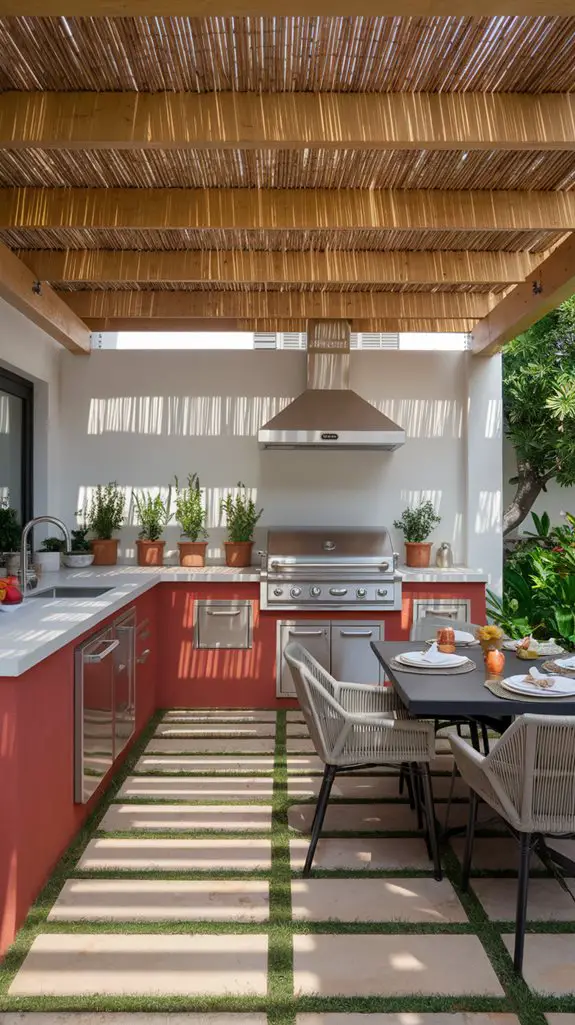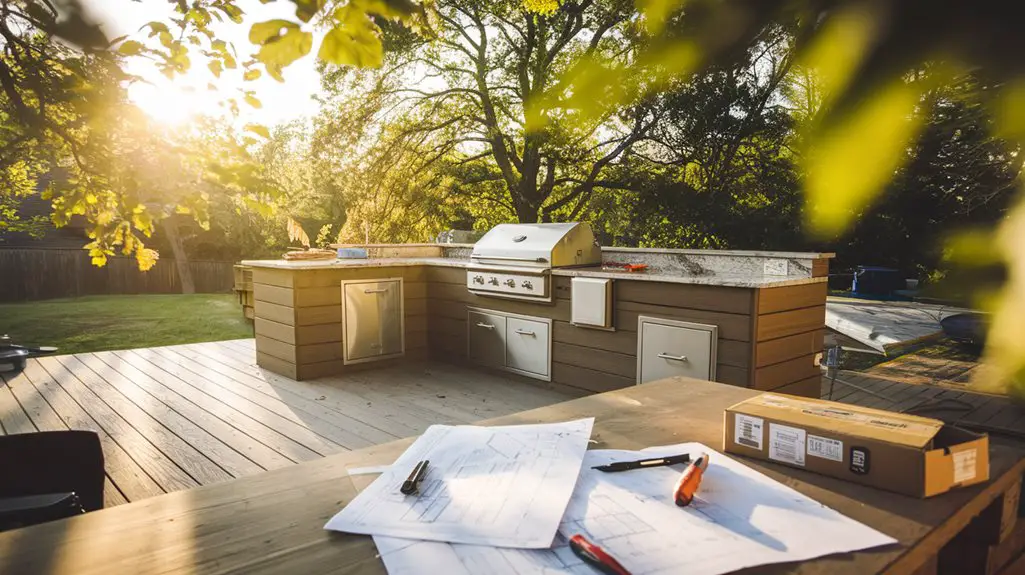Imagine transforming a small backyard into a functional outdoor kitchen, where family gatherings and summer barbecues become effortless. To achieve this, you need to assess your space and understand your specific needs. It's not just about cooking; it's about creating a versatile environment. With a clear plan, you can avoid common pitfalls that beginners face. What are the key considerations to guarantee your outdoor kitchen project is a success?
Assess Your Space and Needs
Before diving into your outdoor kitchen project, it's important to assess your space and needs to guarantee your design is both functional and enjoyable.
Start by measuring your area, considering factors like sunlight, wind direction, and proximity to your home. Identify any existing structures, such as trees or walls, that may influence your layout.
Think about how you'll use the space—do you need a grill, a sink, or ample counter space for food prep?
Design for flow: facilitate easy movement between cooking, dining, and entertaining zones.
Finally, consider the aesthetics; select materials and colors that complement your surroundings. Additionally, exploring modern outdoor kitchen concepts can inspire innovative designs that maximize your small backyard space.
Set a Realistic Budget
Setting a realistic budget is essential for ensuring your outdoor kitchen project stays on track and meets your expectations.
Start by listing all costs involved, including appliances, countertops, cabinetry, and plumbing. Don't forget to factor in permits, installation, and any landscaping changes.
Research prices online and visit local suppliers to gauge material costs. It's vital to include a buffer—typically 10-15%—for unexpected expenses.
Prioritize your must-haves versus nice-to-haves to keep your budget in check. If you're tight on funds, consider scaling back on certain features or opting for mid-range options. Additionally, consider investing in functional outdoor kitchen designs to maximize your space and cooking efficiency.
Choose Durable Materials

Choosing durable materials is essential for the longevity and functionality of your outdoor kitchen. Opt for weather-resistant materials like stainless steel for appliances and cabinets, as they resist rust and corrosion.
Concrete or stone countertops offer both strength and aesthetic appeal, while ceramic or porcelain tiles can withstand the elements without fading.
When selecting flooring, consider non-slip options such as textured pavers or composite decking to enhance safety.
For cabinetry, marine-grade plywood or high-density polyethylene can withstand moisture and UV exposure.
Don't forget about accessories; choose high-quality hinges and fasteners that can endure outdoor conditions. Additionally, incorporating budget-friendly design tips will help you create a functional space without breaking the bank.
Plan for Utilities and Safety
While planning your outdoor kitchen, it's crucial to integrate utilities and prioritize safety to guarantee a seamless cooking experience. Start by mapping out gas lines, electrical outlets, and water sources. Verify all installations comply with local codes to avoid hazards. Incorporate safety measures like proper ventilation and secure storage for flammable materials. Additionally, consider including must-have items that enhance the outdoor cooking experience.
Here's a quick reference table to help you:
| Utility Type | Considerations | Safety Measures |
|---|---|---|
| Gas | Secure connections, ventilation | Leak detectors, shut-off valves |
| Electricity | Weatherproof outlets, proper wiring | GFCI protection, circuit breakers |
| Water | Sufficient pressure, drainage | Non-slip surfaces, hoses away from heat |
This strategic planning will enhance both functionality and safety in your outdoor kitchen.
Incorporate Functional Design

To create an outdoor kitchen that truly enhances your cooking experience, it's essential to prioritize functional design from the outset.
Start by evaluating your workflow: consider the triangle of your cooking, prep, and serving areas. Place the grill, sink, and refrigerator within easy reach to streamline your tasks.
Use durable materials like stainless steel for appliances and weather-resistant surfaces to guarantee longevity. Incorporate adequate storage solutions for utensils and cookware, keeping your workspace clutter-free.
Don't forget about lighting; well-placed fixtures can illuminate your cooking area for nighttime use. Additionally, consider adding contemporary outdoor kitchen setups that feature islands, which can provide extra prep space and enhance the overall aesthetic of your outdoor area.
Finally, think about seating arrangements that encourage interaction without obstructing movement, making sure your outdoor kitchen is both efficient and inviting for entertaining guests.
Add Personal Touches
Incorporating personal touches into your outdoor kitchen not only showcases your style but also makes the space feel uniquely yours. Think about adding elements that reflect your personality and interests. Consider custom cabinetry, unique lighting fixtures, or even a vibrant backsplash that resonates with your favorite colors. Stylish outdoor kitchens often feature built-in seating that enhances both functionality and comfort.
| Element | Personal Touch | Emotional Impact |
|---|---|---|
| Color Palette | Bold, cheerful hues | Invokes joy and energy |
| Decorative Items | Family photos or artistic pieces | Creates connection and warmth |
| Functional Layout | A layout that fits your cooking style | Enhances comfort and usability |
These details can transform your outdoor kitchen into a welcoming environment, making it perfect for gatherings and family meals.
Start Small and Expand Over Time
Starting your outdoor kitchen project on a smaller scale can be both practical and rewarding, especially if you're managing budget constraints or uncertain about your design choices.
Begin with essential elements like a grill, a prep station, and basic seating. This approach allows you to test your layout and functionality without overwhelming costs.
As you gain confidence and clarity about your preferences, you can gradually incorporate additional features—like a pizza oven, sink, or bar area. Incorporating outdoor kitchen layouts can help you optimize your space for entertaining guests.
Consider seasonal adjustments, too; adding outdoor lighting or a fire pit can enhance your space over time.
Conclusion
As you begin your outdoor kitchen journey, think of it as planting a seed. With careful planning and nurturing, your culinary oasis will flourish. Remember to assess your space, budget wisely, and choose materials that withstand the elements. Each design choice is a step in crafting a vibrant garden of flavors, inviting friends and family to gather. Start small, like a sapling, and watch your outdoor kitchen grow into a haven of delicious memories and joyful gatherings.




